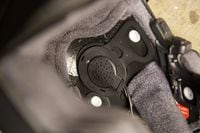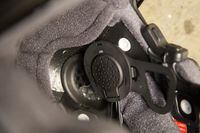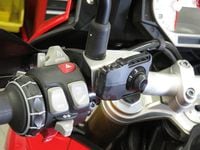Elegance in design is enduringly desirable. We all love things that fit together like carefully crafted puzzles, engineered so that every piece fits just so. In the world of Bluetooth headsets, some of us find the tangle of wires and exposed brackets—to say nothing of the glob of electronics stuck to the side of the helmet—simply too much to bear.
Sena’s approached this issue before with the 10R, a surface-mount system that’s less than half an inch thick, a sleek little nubbin on the side of your helmet. But the 10R’s layout demands a complicated installation procedure, finding space for the wires and the batter that sticks to the back of the helmet. Kinda like fixing one problem and creating another. If only this kind of low-profile system could be made for specific helmets...
And now it is, in the 10U, which is built for five specific helmets: Shoei’s Neotec, GT-Air, and J-Cruise, Schuberth’s C3/C3Pro, and a range of Arai full-face helmets. Rather than bolt a baby-fist-sized controller to the outside of the helmet, the 10U is designed to fit its major components into recesses inside the helmet.
This concept makes the 10U a literal snap to install—the system is designed for a specific helmet’s interior, so the speakers fit right into the existing slots, the battery into the open space at the lower, rear part of the shell, and the microphone peeks out from the cheek pad. Wires are exactly the right length for the application. A separate antenna slides into the space between the liner and the shell. Once you have the interior removed, installing the 10U takes all of 10 minutes. It’s really that slick.
Despite the novel layout, the 10U retains the functionality of the higher-end 20S and 10R models, including Bluetooth 4.0, a built-in battery, and support for Sena’s remote controls. In fact, you’ll need one of the two remotes to have all the 10U’s features at hand. The two buttons in the eye port are labeled + and -, and are used to power up the system, adjust volume, and manage a handful of other functions. Obviously, this is not meant as a full-time solution, since you have to open the faceshield first.
Instead, you’ll use the Sena remote. One comes with the 10U, and it’s meant to clip around the inboard side of your bike’s left handgrip. It has two small buttons plus a five-way joystick that unlocks all the features of the 10U, including bike-to-bike communication, music and other information from your smart phone, an audio connection to your GPS, and even FM radio. The idea is great, but the execution works well only on cruisers with large, wide grips; otherwise the remote gets in the way. As an alternative, I used the $100 Sena Wristband Remote. It’s meant to strap to your right wrist, but I mounted the unit to my BMW S1000XR’s handlebar within easy reach of my left hand. There, the concept works well, giving full access to all the features without having to fumble around on the side of your helmet.
In virtually all aspects, the 10U performs as well as the 20S, Sena’s top-line conventional communicator. The operating logic on the remote is a mix of 10R and 20S, but you’ll learn it quickly. Audio quality is excellent, range is good (just shy of company claims), and battery life very good, easily 8 hours of more-or-less continuous use. My one complaint is that the stubby microphone picks up a massive amount of wind noise with the Neotec’s chinbar open. Closed, it’s not bad—though still not quite as clear and static-free as the boom mic from the 20S.
The 10U can connect with two other Bluetooth users for a three-way channel, but a fourth can be included by pairing with another rider. Generally, bike-to-bike audio quality is excellent with two riders and degrades the more people are on the line. Fortunately, it’s easy to “punch in” and “punch out” of conversations so you don’t have to listen to your friends running comments on the wildlife or the need to urinate. Happily, the operating logic of the remotes makes it possible to manage intercom contacts, play music from your phone, and even take calls without having to remember how long to push a given button. The joystick toggles up and down for volume, left and right for track (replay or advance); the “front” button handles intercom duties; and the “rear” button is largely dedicated to phone functions. It’s easy to learn which button to push to get what you want.
Functionally, the $300 10U is not a lot different from the same-price 20S, but if you love the look of elegant design, or just disdain the appearance of the “Bluetooth blob” on the side if your helmet, it’s the one to choose.
Sena SMH10U
Price $300
Contact: senabluetooth.com
MC Grade: A-
Verdict: Beautifully designed for a perfect fit in your helmet. A noisy microphone is the biggest complaint.










/cloudfront-us-east-1.images.arcpublishing.com/octane/J7NVVU56GS4CJZMK5H5XIPIML4.jpg)





/cloudfront-us-east-1.images.arcpublishing.com/octane/MUQLOVLL2ZDGFH25ILABNBXKTI.jpg)
/cloudfront-us-east-1.images.arcpublishing.com/octane/TNOU5DNE2BC57MFPMGN2EIDXAM.jpg)
/cloudfront-us-east-1.images.arcpublishing.com/octane/GTCXACQGJ5HAPDTGWUQKDEH44E.jpg)
/cloudfront-us-east-1.images.arcpublishing.com/octane/S35YGSEMEZB4BLTDJTSZPF4GLA.jpg)
/cloudfront-us-east-1.images.arcpublishing.com/octane/5UOT6HPX2JFMRJAX6EH45AR4MQ.jpg)
/cloudfront-us-east-1.images.arcpublishing.com/octane/OKWOJWAKP5EP3OACCRRWPCIX2Q.jpg)
/cloudfront-us-east-1.images.arcpublishing.com/octane/2WF3SCE3NFBQXLDNJM7KMXA45E.jpg)
/cloudfront-us-east-1.images.arcpublishing.com/octane/G4MG6OUCJNBSHIS2MVVOTPX65E.jpg)
/cloudfront-us-east-1.images.arcpublishing.com/octane/IIGGWFOTOJGB7DB6DGBXCCMTDY.jpg)
/cloudfront-us-east-1.images.arcpublishing.com/octane/QSTCM6AVEZA5JJBUXNIQ3DSOF4.jpg)
/cloudfront-us-east-1.images.arcpublishing.com/octane/U4I7G625B5DMLF2DVIJDFZVV6M.jpg)
/cloudfront-us-east-1.images.arcpublishing.com/octane/B6XD6LS6IVCQPIU6HXDJSM3FHY.jpg)
/cloudfront-us-east-1.images.arcpublishing.com/octane/ICL63FEDDRDTTMINYICCEYGMDA.jpg)
/cloudfront-us-east-1.images.arcpublishing.com/octane/FCGZHQXRBZFLBAPC5SDIQLVF4I.jpg)
/cloudfront-us-east-1.images.arcpublishing.com/octane/WNOB6LDOIFFHJKPSVIWDYUGOPM.jpg)

/cloudfront-us-east-1.images.arcpublishing.com/octane/X33NU3E525ECRHXLNUJN2FTRKI.jpg)
/cloudfront-us-east-1.images.arcpublishing.com/octane/6KKT5NNL2JAVBOXMZYS5ZO76YA.jpg)
/cloudfront-us-east-1.images.arcpublishing.com/octane/J5RKG5O455GMPGQRF2OG6LRT7A.jpg)
/cloudfront-us-east-1.images.arcpublishing.com/octane/GX2CIZKQVRH2TATDM26KFG2DAE.jpg)
/cloudfront-us-east-1.images.arcpublishing.com/octane/ZWIDYSAKQZHD5BHREMQILXJCGM.jpg)
/cloudfront-us-east-1.images.arcpublishing.com/octane/CYUHJZCTSJCH3MRAQEIKXK7SCQ.jpg)
/cloudfront-us-east-1.images.arcpublishing.com/octane/LKOFINY56FCXJCANJ5M7ZDQUBY.jpg)
/cloudfront-us-east-1.images.arcpublishing.com/octane/4NBPDACMWJH63JQYJVK3QRBDZI.jpg)